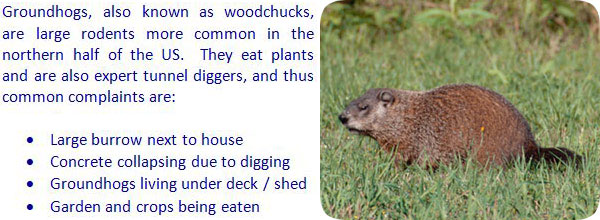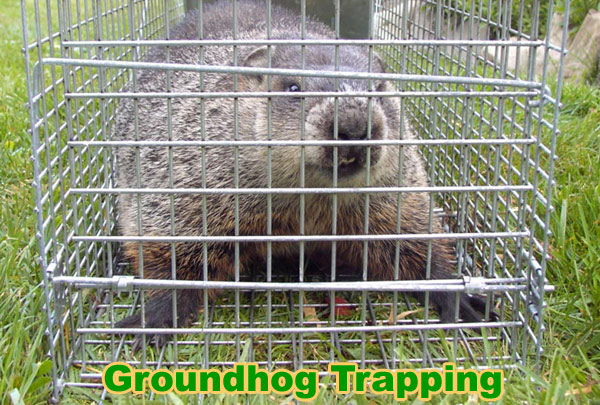- info@wildlifeanimalcontrol.com
Call us for help in your town
Wildlife Control Education
Groundhog Trapping - How To Trap

Need groundhog removal in your hometown? We service over 500 USA locations! Click here to hire us in your town and check prices - updated for year 2020.
How to Trap a Groundhog
Groundhogs can be pests. They live underground in burrows and come out during the day to feed on vegetation in your yard. This can include flowers, saplings and vegetables and fruits in your garden.
Understandably, the groundhog’s eating habits can cost you hundreds of dollars in lost produce. Before you decide to kill them, take a look at humane ways to catch a groundhog. They can often be caught and relocated.
Figure out the location of the burrow
Groundhogs live underground in burrows. There will be more than one entrance to a burrow and it’s important to locate them all. Entrances are usually 10 – 12 inches in diameter and will have mounds of dirt around the outside.
Take inventory of what the groundhog has been eating.
Look around your yard and garden to see what kind of vegetation is being damaged. If there is a bite taken out of the side of a cucumber or tomato, or the leafy tops of your carrots have been eaten, note it. In order to catch them, you will need effective bait.
Click here to read about
what kind of bait catches groundhogs.

Live traps
The best way to catch a groundhog is with a live, or no-kill, trap. These can be found in home and garden stores in your neighborhood. A popular brand of live traps is “Havahart”. These no-kill traps allow you to catch the groundhog in a humane way and relocate them far away from your home.
Live traps work via a spring loaded door. You place the bait inside the trap, the groundhog enters to eat the bait, and their weight causes the spring loaded mechanism to snap the door closed behind them.
Learn more: What Should I Do If I find An Orphaned Baby Raccoon ?
Baiting live traps
Taking inventory of what the groundhog has been eating comes in here. Those items are what you will use to bait your trap. So, if the groundhog is going for your heirloom tomatoes, cucumbers, or any other specific vegetation, use those to tempt the groundhog into the trap.
Bait your trap in the most effective way possible. After you buy it, set it outside in the sun for a couple of days. This will get rid of any scents lingering on the trap. You can also put it in boiling water, if you have a large enough container. Wear gloves when moving, setting and baiting the trap to hide your scent from the groundhog.
Setting your traps
Groundhogs may look like clumsy, dumb creatures. They are actually quite smart. They know when something looks or smells funny.
Late winter and early spring are the best times to find burrows. The lack of lush vegetation makes them easier to spot. The groundhogs will stop hibernating and will have to come out to search for food more often. Since their preferred food will be less abundant, they will have to come out more often.
Place your no-kill trap just outside the entrance to the groundhog’s burrow so you can catch it when it comes out to search for a meal. To quickly and effectively trap the groundhog, place logs directing the groundhog toward the trap.
If your trap is new, you will need to age it a bit so it loses its shine. Cover the trap with vegetation or a trap cover to hide it. You may need to direct the groundhog toward the trap with something called “woodchuck lure”. This is a scent that groundhogs love and will follow to the trap. Put a few drops on or around the bait as well.
What to do when you have caught a groundhog
When you have finally caught the pesky critter that has been destroying your garden, there are a couple of options to get rid of it. You can release it far away from your home so it will not come back. You can also call the local animal shelter to ask their advice.
Another thing to do is call animal control or a professional trapper in the area. They will often come out to pick up the groundhog and take care of relocation or disposal for you.
Remember that while groundhogs may not be desirable in your garden, they are an important part of the local ecosystem. Keep that in mind when you are looking for ways to catch a groundhog and try to capture them alive.
More in-detail how-to groundhog removal articles:
Information about how to kill a groundhog - with poison or other methods.
Information about how to keep groundhogs away - prevention techniques.
Information about how to catch a groundhog - remove one stuck in the house.
Information about groundhog repellent - analysis of types and effectiveness.
This site is intended to provide groundhog education
about how to trap a groundhog in your house or
property and and information about groundhog trapping, so that you can make an informed decision
if you need to deal with a groundhog problem. This site provides many groundhog control articles and strategies, if
you wish to attempt to solve the problem yourself. If you are unable to do so, which is likely with many
cases of groundhog removal, please go to the home page and click the USA map, where I have wildlife removal experts
listed in over 500 cites and towns, who can properly help you with your nuisance groundhog.
Click here to
read more about how to get rid of groundhogs.

















